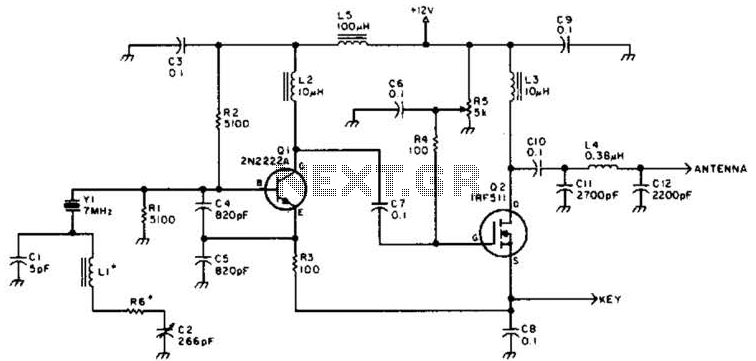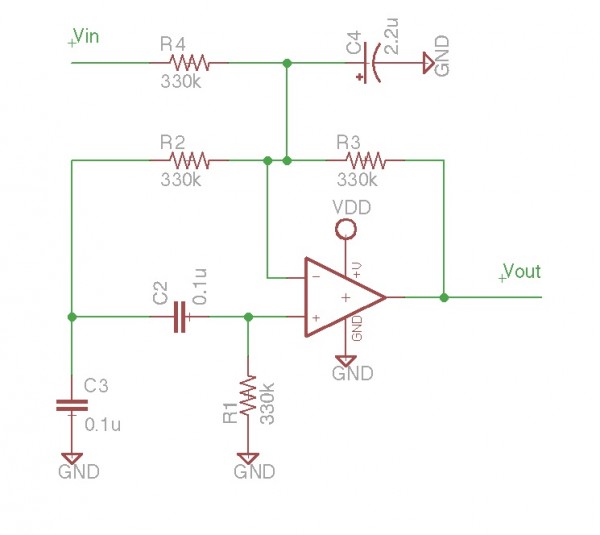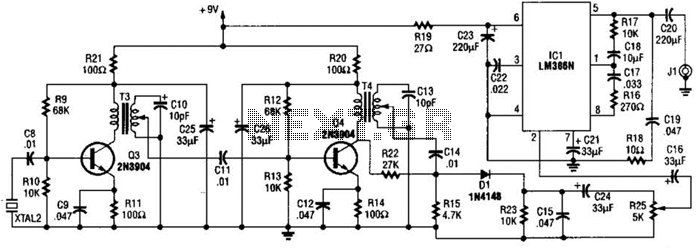
Opamp VHF FM Transmitter

Integrated circuits (ICs) that were previously too costly for hobbyists are now more affordably priced. An example is the AD8099 from Analog Devices, which is available for only a few pounds. The AD8099 is a very fast operational amplifier (op-amp) with a slew rate of 1600 V/µs and features high-impedance inputs with low input capacitance. Its bandwidth is substantial, maintaining a gain of nearly 40 at 100 MHz. This capability allows for the creation of an RC oscillator. The presented circuit exhibits several notable characteristics. Firstly, unlike typical oscillators that utilize transistors, this design does not include inductors. Secondly, there is no requirement for a varicap diode for FM modulation. The op-amp is configured as a Schmitt trigger with minimal hysteresis, and the output is fed back through an RC circuit. Consequently, the trimmer capacitor is continuously charged and discharged once the voltage reaches the hysteresis threshold, causing the output to toggle continuously and resulting in a square wave output voltage. With a 10-pF trimmer capacitor, the frequency can be adjusted within the VHF FM broadcast band (88-108 MHz), providing sufficient stability for this application. The output voltage reaches approximately 6 Vpp when powered by a 9 V supply, with the transmitter power around 50 mW at a 50-ohm load, which is significantly higher than the average oscillator using a transistor. With a short antenna of about 10 cm, the circuit is adequate for home use as a test transmitter. However, due to the presence of harmonics in the output signal, the use of an outdoor antenna is discouraged unless an additional filter or adapter (such as a pi-filter) is implemented. FM modulation is achieved through the modulation of hysteresis, affecting the oscillator frequency. An audio signal of approximately 20 mVpp is adequate for achieving a reasonable output amplitude. The op-amp comes in an 8-pin SOIC package (specifically the version with the RD8 suffix), with pin spacing of 1/20 inch (1.27 mm), which is manageable for soldering with appropriate tools. If SMD components are employed for the remaining parts, the circuit can be minimized in size. Optionally, a single transistor may be integrated to serve as a microphone amplifier. The power supply voltage should not exceed 12 V, as the IC cannot tolerate higher levels. At 9 V, the current consumption is only 15 mA. As with all free-running oscillator circuits, this design's output frequency is sensitive to power supply voltage variations, making a voltage regulator essential for optimal stability. An additional design consideration is its application as a voltage-controlled oscillator (VCO) for PLL circuits. By substituting the trimmer capacitor with a varicap diode, the frequency range can exceed that of an LC oscillator. This is because, in an LC oscillator, the tuning range is proportional to the square root of the capacitance ratio, whereas in an RC oscillator, it corresponds to the entire capacitance ratio. For instance, with a capacitance ratio of 1:9, an LC oscillator can be tuned over a range of 1:3, while an RC oscillator achieves a range of 1:9. Furthermore, the circuit can provide sufficient power to directly drive a diode mixer, such as an SBL-1, which requires a local oscillator signal with a power of 5 to 10 mW; this oscillator can deliver 50 mW. A simple attenuator composed of a couple of resistors suffices to adapt the two systems.
The AD8099 operational amplifier circuit described functions effectively as an RC oscillator, leveraging its high-speed characteristics and stability. The configuration as a Schmitt trigger allows for reliable oscillation without the need for inductive components, making the design simpler and more compact. The modulation technique used, which involves varying the hysteresis, provides a flexible means of frequency control, suitable for applications in VHF FM broadcasting. The design can be further optimized by ensuring proper power supply regulation to maintain frequency stability and by considering the integration of additional components like a microphone amplifier for enhanced functionality. The ability to drive a diode mixer directly adds versatility, allowing this circuit to be employed in various RF applications. Overall, this circuit presents a practical solution for hobbyists and professionals looking to explore RF transmission and modulation techniques.ICs that in the past were far too expensive for the hobbyist tend to be more favourably priced these days. An example of this is the AD8099 from Analog Devices. This opamp is available for only a few pounds. The AD8099 is a very fast opamp (1600 V/ms) and has high-impedance inputs with low input capacitance.
The bandwidth of the opamp is so large that at 100 MHz it still has a gain of nearly 40. This means that this opamp can be used to create an RC oscillator. The circuit presented here realises that. The circuit has a few striking characteristics. Firstly, unlike normal oscillators that contain transistors this one does not have any inductors. Secondly, there is no need for a varicap diode to do the FM modulation. The opamp is configured as a Schmitt trigger with only a small amount of hysteresis. The output is fed back via an RC circuit. In this way, the trimmer capacitor is continually being charged and discharged when the voltage reaches the hysteresis threshold. The output continually toggles as a consequence. This results in a square wave output voltage. With a 10-pF trimmer capacitor the frequency can be adjusted into the VHF FM broadcast band 88-108 MHz).
The frequency of the oscillator is stable enough for this. The output voltage is about 6 Vpp at a power supply voltage of 9 V. The transmitter power amounts to about 50 mW at a load of 50R. This is about 20 times as much as the average oscillator with a transistor. With a short antenna of about 10 cm, the range is more than sufficient to use the circuit in the home as a test transmitter. Because the output signal is not free from harmonics the use of an outdoor antenna is not recommended.
This requires an additional filter/adapter at the output (you could use a pi-filter for this). The FM modulation is achieved by modulating the hysteresis, which influences the oscillator frequency. An audio signal of about 20 mVpp is sufficient for a reasonable output amplitude. The package for the opamp is an 8-pin SOIC (provided you use the version with he RD8 suffix). The distance between the pins on this package is 1/20 inch 1. 27 mm). This is still quite easy to solder with descent tools. If SMD parts are used for the other components as well then the circuit can be made very small. If necessary, a single transistor can be added to the circuit to act as microphone amplifier. The power supply voltage may not be higher than 12 V, because the IC cannot withstand that. The current consumption at 9 V is only 15 mA. As with all free-running oscillator circuits, the output frequency of this specimen is also sensitive to variations of the power supply voltage.
For optimum stability, a power supply voltage regulator is essential. As an additional design tip for this circuit, we show an application as VCO for, for example, a PLL circuit. When the trimmer capacitor is replaced with a varicap diode, the frequency range can be greater than that of an LC oscillator.
That`s because with an LC-oscillator the range is proportional to the square root of the capacitance ratio. With an RC oscillator the range is equal to the entire capacitance ratio. For example: with a capacitance ratio of 1:9, an LC oscillator can be tuned over a range of 1:3. With an RC oscillator this is 1:9. For the second tip, we note that the circuit can provide sufficient power to drive a diode mixer (such as a SBL-1) directly.
This type of mixer requires a local oscillator signal with a power from 5 to 10 mW and as already noted, this oscillator can deliver 50 mW. A simple attenuator with a couple of resistors is sufficient in this case to adapt the two to each other.
🔗 External reference
The AD8099 operational amplifier circuit described functions effectively as an RC oscillator, leveraging its high-speed characteristics and stability. The configuration as a Schmitt trigger allows for reliable oscillation without the need for inductive components, making the design simpler and more compact. The modulation technique used, which involves varying the hysteresis, provides a flexible means of frequency control, suitable for applications in VHF FM broadcasting. The design can be further optimized by ensuring proper power supply regulation to maintain frequency stability and by considering the integration of additional components like a microphone amplifier for enhanced functionality. The ability to drive a diode mixer directly adds versatility, allowing this circuit to be employed in various RF applications. Overall, this circuit presents a practical solution for hobbyists and professionals looking to explore RF transmission and modulation techniques.ICs that in the past were far too expensive for the hobbyist tend to be more favourably priced these days. An example of this is the AD8099 from Analog Devices. This opamp is available for only a few pounds. The AD8099 is a very fast opamp (1600 V/ms) and has high-impedance inputs with low input capacitance.
The bandwidth of the opamp is so large that at 100 MHz it still has a gain of nearly 40. This means that this opamp can be used to create an RC oscillator. The circuit presented here realises that. The circuit has a few striking characteristics. Firstly, unlike normal oscillators that contain transistors this one does not have any inductors. Secondly, there is no need for a varicap diode to do the FM modulation. The opamp is configured as a Schmitt trigger with only a small amount of hysteresis. The output is fed back via an RC circuit. In this way, the trimmer capacitor is continually being charged and discharged when the voltage reaches the hysteresis threshold. The output continually toggles as a consequence. This results in a square wave output voltage. With a 10-pF trimmer capacitor the frequency can be adjusted into the VHF FM broadcast band 88-108 MHz).
The frequency of the oscillator is stable enough for this. The output voltage is about 6 Vpp at a power supply voltage of 9 V. The transmitter power amounts to about 50 mW at a load of 50R. This is about 20 times as much as the average oscillator with a transistor. With a short antenna of about 10 cm, the range is more than sufficient to use the circuit in the home as a test transmitter. Because the output signal is not free from harmonics the use of an outdoor antenna is not recommended.
This requires an additional filter/adapter at the output (you could use a pi-filter for this). The FM modulation is achieved by modulating the hysteresis, which influences the oscillator frequency. An audio signal of about 20 mVpp is sufficient for a reasonable output amplitude. The package for the opamp is an 8-pin SOIC (provided you use the version with he RD8 suffix). The distance between the pins on this package is 1/20 inch 1. 27 mm). This is still quite easy to solder with descent tools. If SMD parts are used for the other components as well then the circuit can be made very small. If necessary, a single transistor can be added to the circuit to act as microphone amplifier. The power supply voltage may not be higher than 12 V, because the IC cannot withstand that. The current consumption at 9 V is only 15 mA. As with all free-running oscillator circuits, the output frequency of this specimen is also sensitive to variations of the power supply voltage.
For optimum stability, a power supply voltage regulator is essential. As an additional design tip for this circuit, we show an application as VCO for, for example, a PLL circuit. When the trimmer capacitor is replaced with a varicap diode, the frequency range can be greater than that of an LC oscillator.
That`s because with an LC-oscillator the range is proportional to the square root of the capacitance ratio. With an RC oscillator the range is equal to the entire capacitance ratio. For example: with a capacitance ratio of 1:9, an LC oscillator can be tuned over a range of 1:3. With an RC oscillator this is 1:9. For the second tip, we note that the circuit can provide sufficient power to drive a diode mixer (such as a SBL-1) directly.
This type of mixer requires a local oscillator signal with a power from 5 to 10 mW and as already noted, this oscillator can deliver 50 mW. A simple attenuator with a couple of resistors is sufficient in this case to adapt the two to each other.
🔗 External reference





